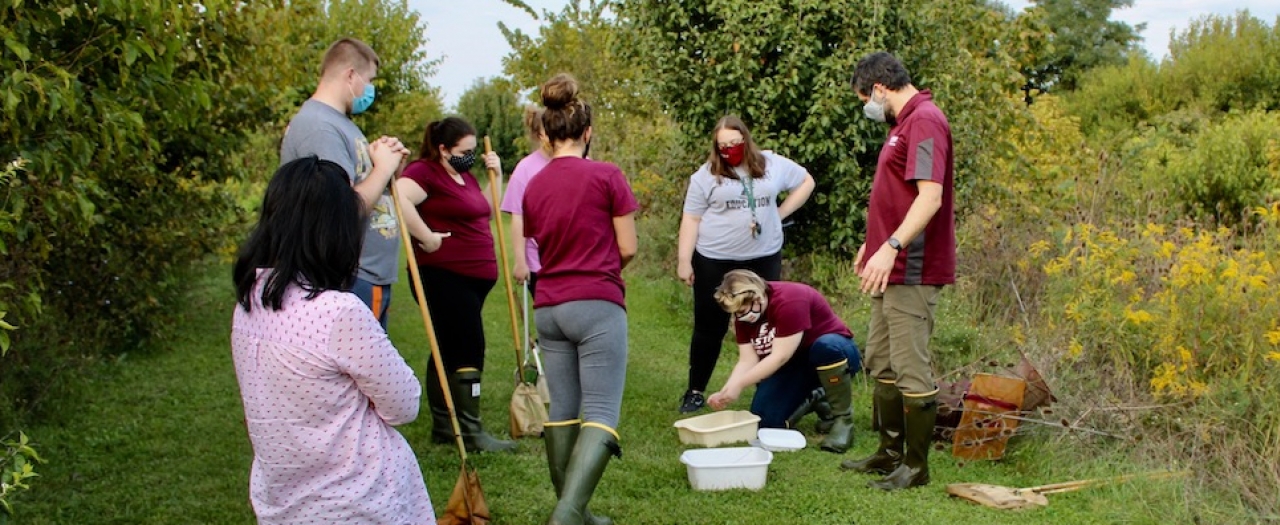Dr. Stephen Richter is the poster child for what an avid outdoorsman should look like. He’s wearing a faded yellow The North Face t-shirt while we talk over Zoom in his garage, which, of course, is full of mountain bikes. He’s certainly no stranger to spending time “in the field,” which is a biologist’s term for where they do their research (in the woods and the water).
 When he started his collegiate journey at Berry College in Georgia, pulling salamanders out of creeks wasn’t on the agenda.
When he started his collegiate journey at Berry College in Georgia, pulling salamanders out of creeks wasn’t on the agenda.
“When I started school there, I was pre-med, I wanted to be a doctor-or so I thought. I wanted to be a pediatrician,” Richter said. “Then I realized that I never really thought twice about it growing up. I got to college and didn’t do as well as I hoped. I really didn’t have the focus I needed.”
Sceloporus woodi,aka Florida scrub lizards, a small nearly endangered multi-colored lizard native to Florida, changed his life. “The first meaningful experience and the one that really changed my outlook was I got a chance to go to Florida with a faculty member and study scrub lizards in the Ocala National Forest. We lived in a scout camp by a lake and it was just an amazing experience,” Richter said. “I realized that was a possibility for me as a career and I really loved that. I knew I wanted to do something to understand reptiles and amphibians and to do conservation work to help them.”
He realized that if research was going to be a big part of his career, he needed to get a master’s degree and a Ph.D. (which he did in Biology and Zoology at the University of Southeastern Louisiana and the University of Oklahoma, respectively). And after that he figured he’d end up with a government agency. “I’ve been incredibly lucky. EKU has a really deep history with decades of wildlife and field ecology. With EKU supporting field-based, applied conservation management types of research, was a big draw. And then when I learned about Maywoods and the Division of Natural Areas, I aspired to become the director,” Richter said.
In Aug. 2019, Richter was named Natural Areas Director. “Being able to do conservation research and also implement it has been really rewarding.”
His career is the best of both worlds at EKU, Richter said. He set out to do preservation at an agency or research in the academic world, and now he does both and gets to teach the next generation. EKU’s Division of Natural Areas is run similarly to a government agency. “We implement conservation practices that are informed by research, and protect lands and provide educational, research, and recreational opportunities to the public and EKU students and faculty.”
But it’s his bond with students, like he formed with his professors early in his career, that drives his work at EKU. He established the Richter Lab in 2005 with the “primary goals of understanding factors that shape the distribution and natural history of amphibians and reptiles and to use the information to inform conservation and management of herptiles and their terrestrial, aquatic, and wetland habitats,” according to his website.
Fifty-five current and former undergraduate and graduate students are featured prominently and make up the membership of his lab at the University.
Down the road, Richter hopes to get as many students involved as possible in research and to help land management agencies best use the resources they have available. He also wants to aid making natural resources available to the public while making sure they’re suitable for the natural-occurring wildlife and habitat already there. “My ultimate goal is to put lots of students out there in jobs that think the same way and can do this kind of work,” Richter said.
